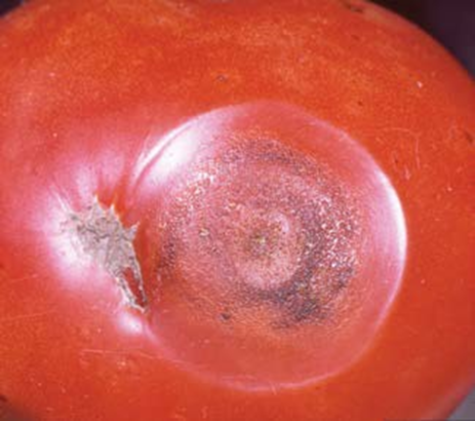Anthracnose on Tomatoes
 Anthracnose results in a fruit rot that reduces the quality and yield of tomatoes. This fungal disease is a frequent problem in the latter part of the growing season, specifically on ripening tomato fruit. The symptoms of this disease first appear as small circular, slightly sunken lesions on the surface of ripening fruit. The spots quickly enlarge, becoming bruise-like depressions that develop a water-soaked appearance beneath the skin's surface. Soon after, black concentric rings consisting of numerous small fruiting structures form in the center of the lesions. This disease is common during warm, humid weather after a rain or overhead watering, where the spores splash onto the fruit from the ground. Temperatures over 80 degrees favor disease development.
Anthracnose results in a fruit rot that reduces the quality and yield of tomatoes. This fungal disease is a frequent problem in the latter part of the growing season, specifically on ripening tomato fruit. The symptoms of this disease first appear as small circular, slightly sunken lesions on the surface of ripening fruit. The spots quickly enlarge, becoming bruise-like depressions that develop a water-soaked appearance beneath the skin's surface. Soon after, black concentric rings consisting of numerous small fruiting structures form in the center of the lesions. This disease is common during warm, humid weather after a rain or overhead watering, where the spores splash onto the fruit from the ground. Temperatures over 80 degrees favor disease development.
Several cultural practices can help reduce the incidence of anthracnose. Try to mulch around your tomatoes to prevent the splashing of spores from the soil. You should also support your tomatoes with cages, stakes, or trellises to increase air movement and decrease the likelihood of favorable environmental conditions for infection. Use soaker hoses or drip irrigation to prevent the splashing of the spores onto the fruit from overhead watering (there is only so much we can do with rain). Remove any infected fruit as soon as you notice the damage.
If you have had issues with anthracnose in the past, you can apply preventative sprays. Once the fruits are infected, they can’t be saved. Spray options include the active ingredients Bacillus subtilis, chlorothalonil, copper fungicides, or maneb. Be sure to read the label to check the post-harvest interval (how long after you spray before you can harvest the fruit) and make sure it is labeled for anthracnose and the vegetable you are spraying.

Have questions? Contact our office where our Horticulture Extension Agent will assist you with questions.
Phone: (316) 321-9660
Email: callae@ksu.edu